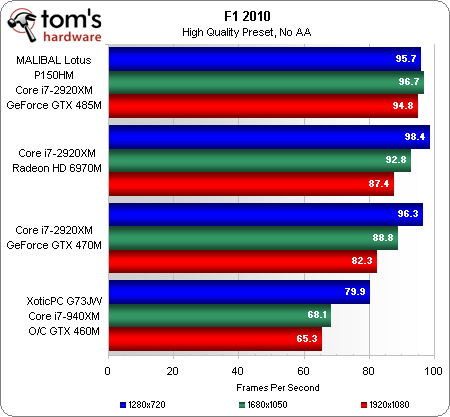MALIBAL's Lotus P150HM: GeForce GTX 485M Gets Its Game On
Using the latest advances from Intel and Nvidia, MALIBAL attempts to prove that portability and performance are no longer mutually exclusive. Can a fully-loaded Lotus P150HM meet the needs of performance enthusiasts and gamers at a more reasonable price?
Benchmark Results: Crysis And F1 2010
XoticPC’s G73JW has been retained in today’s benchmarks to reflect the capabilities of a previous-generation, high-end gaming notebook of similar weight. The firm already has a Sandy Bridge alternative that we hope to test soon.
Yes, the GeForce GTX 485M can play Crysis at the panel’s native resolution and a high level of details, so long as AA is disabled. An elder game, this has become more of a system-wide benchmark, as other engines have been optimized for newer graphics architectures.
1280x720 is a viable option for anyone who really wants to crank up Crysis details on a 16:9 panel, but we’d probably prefer to play the game at the previous settings and 1920x1080, if we still played it.
The GeForce GTX 485M appears CPU-bottlenecked at our lower F1 2010 settings, even though it’s paired with Intel’s awesome Core i7-2920XM. Fortunately, that bottleneck occurs well beyond the minimum FPS needed to experience smooth game play.
F1 2010 apparently prefers AMD's architecture, though the GeForce GTX 485M-equipped Lotus P150HM is still perfectly playable at our highest settings. We even recorded minimum FPS and found that the slowest system in today’s comparison pulled at least 20 FPS throughout the test.
Get Tom's Hardware's best news and in-depth reviews, straight to your inbox.
Current page: Benchmark Results: Crysis And F1 2010
Prev Page Test Settings Next Page Benchmark Results: Just Cause 2 And S.T.A.L.K.E.R.: Call Of Pripyat



